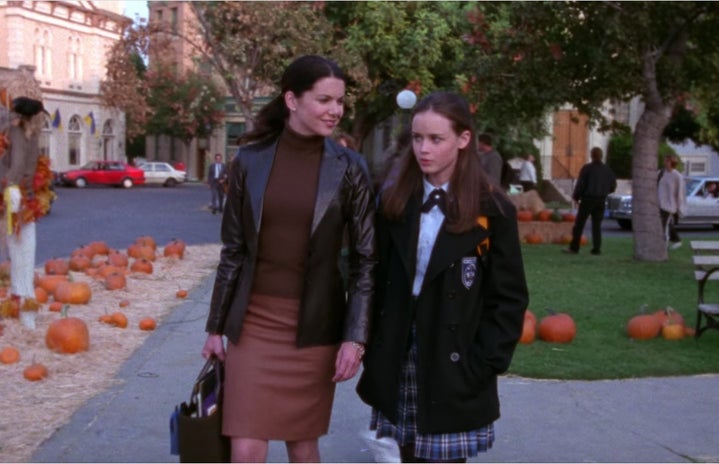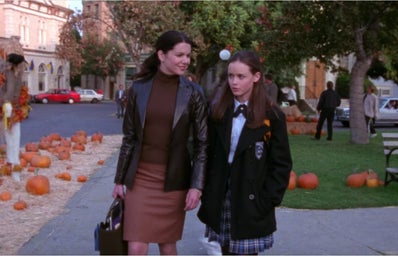Almost everyone in the 21st century with access to online streaming has a comfort show (although whether they’d use those exact words to describe it is debatable). The Office, Friends and How I Met Your Mother are just a few of the many popular TV shows that have fallen into this category, and with good reason. These shows often have characters that come off as relatable or ordinary, which means that people have the ability to identify with their experiences rather than be completely detached from the plotline. Comfort shows also tend to be quite light-hearted and have tensions resolve relatively quickly, which help reduce the feelings of anxiety that people (aka me) may feel watching shows with slightly heavier or more graphic content.
The appeal of Gilmore Girls as a TV show is interesting because it isn’t exactly like the other comfort shows I have listed above. Sure, the show is light and humorous, but I often wonder what the plot of Gilmore Girls actually is(and why I am so invested in it despite it not being that solid one). The baseline of the show is rather simple – the show follows the lives of Lorelai Gilmore and her daughter Rory and begins with them being tasked with visiting Lorelai’s estranged parents once a week in exchange for covering Rory’s school tuition. However, the show is far more than just an insight into their lives in the fictional town of Stars Hollow, and the existence of a (relatively) healthy mother-daughter relationship was not the only thing that struck me as comforting as I watched it.
Let’s start with the mother-daughter theme, though. It is certainly refreshing to watch Lorelai and Rory grow throughout the seasons, and one of the reasons their relationship feels so heartwarming is because it comes off as authentic. The two of them do fight and have disagreements with one another, but at the bottom of it, they are each other’s best friends and closest confidants. Most modern TV shows tend to display the teenage phases of life as those clouded by rebellion and stubbornness; in contrast, Lorelai and Rory’s relationship is one of trust and maturity, where Lorelai helps Rory navigate her formative years whilst Rory provides Lorelai with a shoulder to cry on. More importantly, Lorelai tries her best to not repeat the mistakes she felt her mother, Emily Gilmore, made when raising her. She is determined to break the generational cycle that she believed was responsible for the breakdown of her own maternal relationship. Watching a mother do her best to foster a healthy and safe relationship with her daughter was certainly comforting for me to watch, especially because it subverted common depictions of mothers as distant and cut off from the lives of their teenage children.
The side characters also play a huge role in increasing the appeal of Stars Hollow. Almost all the characters are bubbly and polite, and if not, serve some form of comedic purpose, which makes them exciting to watch. Whether it’s Luke’s quick-wittedness, Sookie’s energetic nature, or Kirk’s deadpanned commentary, there is a form of humour for everyone to connect to. Moreover, the idea of a small American town where everyone knows and gets along with one another creates a safe haven for people that wish to escape their fast-paced and stressful everyday lives.
As I mentioned before, there wasn’t necessarily a strong plotline, so what allowed this show to go on for seven seasons? My guess is that the simplicity of the show was actually an advantage – like other comfort shows, Gilmore Girls does not have insane plot twists or shock factors added to keep the momentum of the show going. Instead, it is the characters and the development of their relationships with one another that drive the show. It makes you feel as if you’re actually watching these people grow, rather than huge time jumps distorting or smoothing over character developments.
The minimal locations – Luke’s diner, Taylor’s grocery store, the Independence Inn – make the show predictable, but in a really good way. I liked knowing exactly where the characters could be, and the minimal surprise changes allowed me to immerse myself in their world completely. The setting of the show is extremely important too. Watching the Gilmores thrive in a small town devoid of chain stores and social media to the tune of soft acoustic music, honestly makes me feel a sense of nostalgia for the early 2000s, as well as the comfort of my childhood home. The show being perpetually always set in the autumn and winter seasons also builds on this cosy and quaint atmosphere, which explains why the cult of Gilmore Girls seems to awaken at the dawn of autumn every year.
I believe Gilmore Girls is a timeless show, as its fundamental relationships have the potential to be relatable and inspiring for generations to come. Life in Stars Hollow makes me want to grab a warm cup of hot chocolate and curl up against the warm fireplace that I most certainly do not own. It makes me want to go to a cafe and have the barista give me my “usual”. It makes me want to lie down next to my mother and tell her about my day, even though I am currently miles away from home. Above all, itt’s these feelings, more than anything else, make Gilmore Girls the perfect comfort show.


